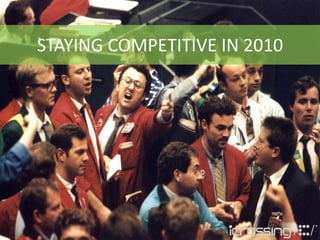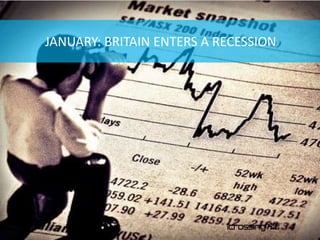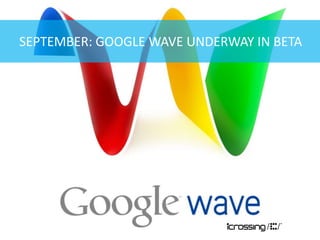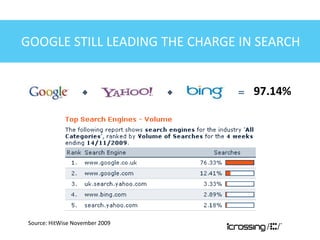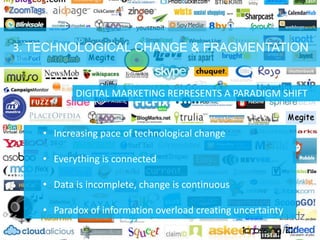Staying Competitive in 2010
- 1. STAYING COMPETITIVE IN 2010
- 2. Seeing your brand through the eyes of a search engine
- 3. Effort & Cost HighPaul’s Tip: Create a framework to measure engagementEffort & Cost LowVolume &Brand ControlADVOCACYAFFINITYAWARENESSEngagementParticipationInvolvementInteraction Influence Intimacy Time on SiteCommentsBookmarksUploadImpressionsPurchaseRatingsBlog PostVisits
- 4. INTEGRATED DIGITAL MARKETING:STAYING COMPETITIVE IN 2010
- 5. PRESENTATION GOALS 2009: the year that was…
- 6. To be competitive in 2010: 1. Integrate your marketing 2. Flex and adapt to change 3. Try one new thing
- 7. 2009:THE YEAR THAT WAS...
- 8. A LANDMARK FOR DIGITAL...
- 9. “INTERNET” ACCOUNTS FOR 24% OF £7.46bn REVENUE“INTERNET” ACCOUNTS FOR 24% OF £7.46bn REVENUETotal advertisingexpenditure£7.46bn% Share of total Ad Revenues, H1 2009Source: Internet Advertising Bureau / PricewaterhouseCoopers
- 10. PAID SEARCH COMPRISES 63% of £1.75bn ‘ONLINE’Tom% Share of total ‘Online’ Revenues, H1 2009Source: Internet Advertising Bureau / PricewaterhouseCoopers
- 11. SEARCH CONTINUES PATTERN OF GROWTHTomOverall spend on Search (£m)Source: Internet Advertising Bureau / PricewaterhouseCoopers
- 12. 2009 TIMELINE OF DIGITAL LANDSCAPEJanuary 23rdFebruaryMarchJune, 1stJuly, 29thAugustSeptemberOct 22nd, AMOct 22nd, PM OctoberOctoberNovemberNovemberBritain enters recessionTwitter begins assault on public consciousnessMatt Cutts confirms ‘Vince’ updateMicrosoft launches BingMicrosoft announces partnership with YahooGoogle’s ‘Caffeine’ in testingGoogle Wave gets underway in betaMicrosoft announces Twitter partnershipGoogle announces Twitter partnershipWindows 7 releasedBeta release of Google Social Search Google give public debut of Chrome OSAdmob bought by Google for $750m (it’s 3rd largest acquisition)http://www.guardian.co.uk/business/2009/jan/24/recession-britainhttp://www.youtube.com/watch?v=LMfWPWUh5uU&feature=player_embeddedhttp://money.cnn.com/2009/07/29/technology/microsoft_yahoo/index.htm?postversion=2009072908http://googlewebmastercentral.blogspot.com/2009/08/help-test-some-next-generation.htmlhttp://www.techcrunch.com/2009/11/26/why-google-wave-sucks/http://news.bbc.co.uk/1/hi/uk/8310716.stmhttp://www.techcrunch.com/2009/11/19/chrome-os-event/http://googleblog.blogspot.com/2009/10/introducing-google-social-search-i.htmlhttp://googlesystem.blogspot.com/2009/11/google-buys-admob.html
- 13. JANUARY: BRITAIN ENTERS A RECESSION
- 14. FEBRUARY: TWITTER BEGINS REAL PUBLIC GROWTH
- 15. MARCH: MATT CUTTS CONFIRMS VINCE UPDATE
- 16. JUNE: MICROSOFT LAUNCHES BING IN THE UK
- 17. JULY: MICROSOFT ANNOUNCES PARTNERSHIP WITH YAHOO!
- 18. AUGUST: GOOGLE LAUNCHES CAFFEINE UPDATE IN SANDBOX FOR FEEDBACK
- 19. SEPTEMBER: GOOGLE WAVE UNDERWAY IN BETA
- 20. OCTOBER: BING & GOOGLE ANNOUNCE TWITTER PARTNERSHIPS
- 21. OCTOBER: WINDOWS 7 WAS RELEASED
- 22. OCTOBER: BETA RELEASE OF GOOGLE SOCIAL SEARCH
- 23. NOVEMBER: GOOGLE GIVES PUBLIC DEBUT OF CHROME OS
- 24. NOVEMBER: ADMOB BOUGHT BY GOOGLE
- 25. GOOGLE STILL LEADING THE CHARGE IN SEARCH97.14%Source: HitWise November 2009
- 26. The Times They Are a-Changin‘...
- 27. 1. SCALE, FLUX AND COMPLEXITY
- 28. 2. HELLO, I’M HERE!ATTENTION DEFICIT DISORDER TomCONSUMERS:Increasingly sophisticated+Informed decision-making+Empowered to choose+
- 29. 3. TECHNOLOGICAL CHANGE & FRAGMENTATIONTomDIGITAL MARKETING REPRESENTS A PARADIGM SHIFT Increasing pace of technological change
- 32. Paradox of information overload creating uncertaintySTAY COMPETITIVE IN 2010...1. INTEGRATE YOUR MARKETING
- 33. DougPPCTHINKING IN SILOS IS NOT THE ANSWERE-CommerceSEOSOCIALITCustomer ServiceDISPLAYMarketing
- 34. TomTIMERESOURCESBUDGETSTARGETSPPCSEOE-COMMERCEMARKETINGSOCIALA TUG OF WAR IS NOT THE BESTWAY TO AN OPTIMUM OUTCOMEDISPLAY
- 35. TomSYNERGY: MAKING PPC AND SEO WORK TOGETHER FOR ENHANCED BENEFIThttp://www.merriam-webster.com
- 36. TomDoug THE BUILDING BLOCKS OF SUCCESSSHARED OBJECTIVESUNIFIED REPORTING
- 38. DougCOMBINE SEO AND PPC TO MAXIMISE VISIBILITYCOMBINE TACTICS TO PLUG VISIBILITY GAPS
- 39. UTILISING DATA TO DRIVE PRECISION
- 40. DougCOORDINATE LANDING PAGE DEVELOPMENT
- 41. TomDOES YOUR HALO FIT?BrandCompetitionSearch termProduct categoryRanking positionTraffic Uplift or Traffic Cannibalisation?
- 42. STAY COMPETITIVE IN 2010...1. INTEGRATE YOUR MARKETING2. FLEX AND ADAPT TO CHANGE
- 44. Tom FIRST MOVER ADVANTAGE
- 45. HAVE A SAFETY NET FOR THE UNEXPECTED…
- 46. Tom HARNESS NEW DEVELOPMENTS
- 47. Tom STAY COMPETITIVE IN 2010...1. INTEGRATE YOUR MARKETING2. FLEX AND ADAPT TO CHANGE3. TRY ONE NEW THING
- 48. TomRE-ASSEMBLE YOUR (ATTRIBUTION) MODEL
- 50. > 300M active usersCountryCity or TownAgeGenderInterestsActivitiesMusicBooksTV ShowsEducationSchoolCollegeRelationshipWorkplacePageGroupLanguagesBirthdaysTimeConnectionsADVANCED TARGETING OF 300m+ USERS
- 51. THE POWER OF MOVIES
- 52. THANK YOUDoug Platts, Head of Natural Search+44 (0) 1273 827 770Doug.Platts@icrossing.co.ukTom Jones, Head of Media+44 (0) 20 7821 2295 Tom.Jones@icrossing.co.ukwww.iCrossing.co.ukhttp://connect.icrossing.co.ukwww.twitter.com/icrossing_ukSome images in this presentation were kindly supplied courtesy of Flickr and its users
Editor's Notes
- Doug: Thank you Paul for the introduction. Hello my name is Doug Platts and I am the Head of Natural Search and this is my colleague Tom Jones who is our Head of Paid Media. Today we want to talk to you about our thoughts on Staying Competitive in 2010Tom: Hello it’s really fantastic to see so many of you here today. Despite the fact Christmas is just around the corner I know that for many of you, this is one of your busiest times of the year, so thank you very much for coming today - your time is very much appreciated. Hopefully you’ll find the talk today interesting and useful, and at the very least, enjoy a glass or two of wine and a mince pie!
- Tom: So, what will we cover today? We will lead off with an overview of the market conditions in 2009 and of the key developments that have been made by the leading players.We will also describe how the current digital landscape poses both some unique challenge and opportunities for today’s online marketersDoug: Following this overview we will then move on to the main part of our talk today and answer How to stay competitive in 2010.We will show you that to be competitive you need to: Integrate your digital marketingFlex and adapt to changeTry one new thing to innovate for growth
- Well, it’s nearly that time of they year again. Fireworks on the Thames, wrapping up warm, welcoming in 2010 and Boris’ free tube home.Perhaps – or perhaps you’ve got more glamorous plans!But, before 2010 rushes up on us, let’s first pause and consider what 2009 has meant for digital. Frankly, it’s been a big one – and with the number of big changes we’ve seen this year – it’s unlikely that, even now, our review of noteworthy events will stand as complete!
- 2009 will be unavoidably remembered for being the year of the longest recession since modern records began in the 1950s. However, for “digital”, truly 2009 was a watershed year in a positive sense – For the first half of the year when TV advertising was down 17% YoY overall online Online advertising grew by 4.6% YoYAnd for the first time ever, “Digital” ad sales overtook TV to become the biggest advertising sector in the UKhttp://www.guardian.co.uk/media/2009/sep/30/internet-biggest-uk-advertising-sector
- The IAB and Pricewaterhouse Cooper study showed that the “internet” accounted for 24% of £7.46bn total advertising spendWhich amounted to £1.75bn being spent online during the first half of 2009
- Search represented the driver of this growth and accounted for 63% of the £1.75bn Notably, these figures do not include SEO investment and so actually these online investment figures are understated.
- A final trend revealed by the IAB’s stats is the unabated growth of search, despite the wider economic meltdown. it’s fair to say that while no one is predicting precipitous growth for 2010, a trend of modest increase is likely to continue as advertisers switch their spend online in the search of accountable investment. A change we have noticed however is that you, our clients, are more than ever before, interrogating your search spend to understand its return on investment and contribution to the bottom line. Here at iCrossing we are very clear that it’s our role to helping you answer these questions.
- As Tom mentioned there has been continuous growth year-on-year in search and if we consider 2009, despite the recession, it is clear that innovation in the digital market place has not slow down. The changes we have seen are very much the foundation stones for further innovation to come. Here is a run-through of some of these key developments in 2009
- In January we officially entered a recession and everyone started tightening their financial waist bands – but that didn’t slow things down in digital
- February: Twitter gained celebrity status and grewMentions on news networks, radio stations and major celebrities further fuelled it’s growth and made it an element to consider for any marketing campaign
- Google launched it’s Vince Update where we had a couple of weeks of major ranking movements. The result was Google started checking what people were searching for after searching for the main keyword and used that to build a bigger picture. If people searched for “insurance” and then searched for “post office”, the post office had a chance to rank for “insurance”.
- Bing launched in the UK – we still wait in anticipation for the full version to come out in the new year
- Microsoft took more steps to gain what market share it could for Bing by announcing a partnership with Yahoo! However this may take a couple of years before we see this integration and experience the full impact of the increased market share for Bing
- In August Google gave us a preview of their Caffeine update. Matt Cutts described it by saying that the “update is primarily under the hood: we’re rewriting the foundation of some of our infrastructure”, and that “some of the search results do change”. Plans are to roll this out in the new year.
- Google Wave was launched into beta and IS now even more widely available. Could this be the latest form of direct marketing available to us? Will it take off as hoped
- October 23rd was a busy day for search. In the morning Bing announced it’s partnership with twitter and how tweets were going to be pulled into search engines.And by the afternoon so had Google. Real-time marketing through search engines is soon to be upon us!
- A new credible operating system for Microsoft where they have promised even more integration with the Internet
- October saw the release of Google Social Search in beta.“Google Social Search” helps you find more relevant public content from your broader social circle
- Google branching out from search and applying pressure on Microsoft in the operating system market
- Admob being bought by Google signal’s their intent to move strongly into this market place
- But even after all these changes, at this time, the search engine landscape is still familiar.In the UK Google still has a 89% market share, with Yahoo! sitting on 6% and Bing bring up 3rd place with nearly 3%.These updates, developments and partnerships have still to take effect and impact on the search engine marketplace.
- But what we need to consider are the wider implications on digital marketing as a whole and the challenges and opportunities posed by the modern web.What is clear is that ‘The times they are a-changing’
- Challenge 1: SCALE, COMPLEXITY AND FLUXSo where are we now?This is the World Wide Web; our online universe. The dots in this complex looking picture represent websites, blogs, widgets, forums, portals and the size and brightness their influence. The lines show connections and flows of traffic – customer journeys through an electronic eco system, if you will.And in this environment we meet a number of challenges. Firstly the medium itself – it is huge!, it is always changing and it is very complex. The Internet is a super connected network and far from channelled.
- The advertising laden streets of Tokyo are a great analogy for the second challenge faced by digital marketers . Digital is a world where advertising is everywhere and literally thousands of companies are competing for the limited attention of consumers. We are in a world where targeted adverts are embedded in your online email client, where text ads are next to every search performed, where banner ads are present on virtually every site visited from the FT to Facebook where advertiser can tout their wares while a consumer is listening to Spotify or playing a game on their iphone In response, consumers are becoming increasingly savvy, cynical, and sophisticated. Consumer standards and expectations are higher than ever before.There is a flip side for consumers - the internet’s advertising overload affords unprecedented choice and the ability to source alternatives.Consumers are in a position of empowered decision making a recent LexisNexis study showed that over 60% of people have chosen not to buy a product or service after reading negative comments online. The internet has also torn down geographical barriers and traditional preconceptions of ‘distance’. Today’s digital marketers are as likely to face the prospect of competing not only with online vendors in Birmingham, UK, but with merchants in Birmingham, Alabama. But of course all these challenges represent a double-edged sword of opportunity...... the opportunity for brands to reach, connect and engage with greater numbers of their target consumers than ever before...the opportunity to reduce their reliance on wasteful mass media advertising...the opportunity to reach consumers in Birmingham Alabama without leaving Solihul...the opportunities to achieve growth on a scale unthinkable even 10 years ago before the advent of the likes of Google, Facebook and Twitter.
- The page of digital innovation and technological change is the third challenge for digital marketers. We’ve seen how search has been consolidated to Google, Yahoo and Microsoft, but people’s time online is split between an ever increasing number of sites and uses: Whether it’s: Email, Clothes Shopping, Skype calls with Australia, finding new RSS feeds, blogging about SEO, Browsing social networks, Looking for a job, Researching your family tree People use the internet to fulfil a literally endless number of needs – with these needs being fuelled and satiated by an endless stream of innovation.Digital marketing is a paradigm shift from traditional marketing, characterised by: Interrelatedness and interdependencies of different digital channels – where everything is in a connected network The tension and paradox of more data and measurability of activity than ever before this data raising as many questions and answers and creating uncertaintyTo cop with this scenario: Planning has to be become iterative, Approaches must be more flexible and adaptive And success requires reinvention, and adoption of new technologyOur challenge as your digital agency is to help you, our clients, navigate this complexity and translate into meaningful action.
- Now that we have seen how the market place is growing and changing to meet consumer needs this leads us nicely to our first point on how to stay competitive in 2010.Integrate your marketing channels
- We understand that there is a necessity to divide different departments for certain functions.However when developing your marketing strategy, thinking in marketing silos is not the answer.To illustrate further perhaps it would help if I were to add some labels...So, we have a situation where the different channels are being separated in their execution and measurement.And we also have different stakeholders each with their own agendas – and agendas which may not necessarily even be aligned to the correct goals Such a scenario can create: Additional complexity for organising of campaigns Barriers to knowledge sharing Difficulties in combining multiple cultures Duplication of effortDespite the fact that I work for an digital marketing agency and you might expect me to say this – it’s my honest and personal view that separating out your digital activities like this is not the optimum way to work. Even if we put all the problems i’ve already mentioned aside – one still has to consider the fact that your customers do not think in nor see the web in channels and – so the unavoidable question beckons: “is this really the right way to organise your digital efforts?”
- The bad thing with thinking in silos is that you can end up with the very tangible problem of a tug-of war where no ground is gained and the prize in the middle remaining out of reach. Free market economics might have shown us that competition can drive up outputs and efficiency but only applies when it’s one entity vs. against another andnot when it’s internal in-fighting for TIME, RESOURCES, BUDGETS and TARGETS with each party seeking to serve their own interests rather than pursue:top-line organisational goals and bottom line profitability
- We believe that effectively integrating your digital marketing is going help you stay competitive in 2010. We want to give you a framework for thinking about how to integrating your other marketing channels by referencing how we have made PPC and SEO work together for the enhanced benefit for our clients.Developing ‘synergies’ between paid and natural search does not need to be difficult – as really it’s just about making the processes work together in harmony. And to use a football analogy – the effect is the difference between having Rooney and Ronaldo in the same team, versus having them play against each other for United and Real MadridDeveloping a unified approach helps with answering complex questions like:What truly is my most effective strategy?Which is my most cost effective area of digital marketing?
- One of the easiest ways to cross-market to your target audience is to use the flexibility of PS to test creatives to inform NS meta descriptionsThe Meta description is the piece of creative copy that appears beneath the Natural search link of the web listing.The Benefit testing and integrating this creative is that with unified marketing messages you will see an increase clickthrough rates for both listings Here is an example of Diesel with top natural rankings and high paid listing. The Diesel meta description does not give the searcher much information of what the website is about or the fact that there is free delivery and returns – as mentioned in the paid listing. Diesel could fill out it’s meta description with more detail of what the search can expect when they visit their site and encourage a higher click-through rate.
- Having an integrated view across all channels helps you identify gaps within each channel.And so by combining you different tactics you can maximise your coverage and traffic levels.Let me explain a little further:You can’t optimise for every term, but you can buy coverage.As I’m sure you’re all well aware, paid search is great at giving you reach – and more appropriately – giving it you quickly. If you’ve got the budget you can immediately rank in position 1 for any term you deem appropriate. Natural search can of course give you this reach – but it takes time. One way in which paid and natural search can work together effectively is to use paid search to give you coverage and reach on long-tail and misspell terms while your natural search strategy builds. As your natural rankings grow you can then evaluate and test whether it’s worth keeping the paid search running in conjunction with your natural search listings.
- By closely aligning marketing tactics – it opens up a whole number of ways to analyse the different datasets, to produce benefits which would not otherwise be realised.So, as an example, here are 4 key tips to produce actionable insights from you Paid and Natural search data.Identify highest spending paid search terms and use to prioritise SEO efforts2. If strategy 1 here is not working because the terms in question are too competitive and getting NS rankings is proving difficult, then an alternative is to look at your paid search conversion funnels and develop an SEO strategy around the keywords assisting PS conversions 3. Compare NS av. Positions vs. PS expenditure – look for the organic listings at the top of P2, which are spending on PPC. These usually represent an easy natural search win to increase their ranking and hence an opportunity to decrease PPC expenditureFinally, cross reference NS converting traffic for an opportunity to increase PS coverage. The advantage here is that if you know the term converts well for organic traffic, then you can usually sustain high PS positioning – and drive more traffic that you are getting from your NS ranking
- The key message for integration here is to ensure when evaluating and optimising different channels you take into account the interplay and interdependencies between each. It’s about identifying the incremental benefits of investing in different channels. In this case the so called ‘halo’ effect is used to describe the beneficial effects in both:Clickthrough rate And Brand recollectionthat can be derived when paid and organic results appear on the same SERP - with the uplift effects being generated from taking up more of the SERP real estate. There are various studies on this, from notably Google and Forrester, and here iCrossing we have worked with many clients and seen this ‘halo ‘effect – but in our view there tends to be two problems with the studies published:Firstly, they tend to imply this effect to be a universal truth & indeed this is not the case as effects will differ by:Brand Search termProductRanking position Competition2. Studies are rarely published which show evidence for the cannibalisation effect which essentially means that when you have paid and natural listings together on a page – there is no net gain and simply an increased cost base. The answerhere, then, is to test - and see what works for you – as there are too many factors to predict what will happen in any one caseWhile in many respects studies in this vein represents the epitome of synergy – to make them possible and worth performing (i.e.to make them empirically valid) you must first have in place a unified reporting
- In the first part of our talk we saw some of the ways in which Google – a leader in search - has been forced to adapt to challenges in the market in 2009. Whether it’s integrating twitter results into their SERPS, expanding into new markets with Chrome or planning their infrastructure requirements with the upcoming caffeine updateOur advice to you would be to follow their lead and look to realise opportunities for yourselves by flexing and adapting to the changing market conditions.
- With update such as Google’s Caffeine update and the integration of twitter into search engines. Brands will be able to communicate with their target audience or identify opportunities for new/better products at a much faster paceBut even without these updates it is still possible to achieve this. Here is a great example that we did with BAA.- Born out of Heathrow terminal changes with the opening of Terminal 5 and customer confusion travel arrangements- Users began searching for information, to ascertain which heathrow terminal they are flying from- Google Insights spotted the breakout in traffic for the term “heathrow which terminal” which informed paid search strategy- Terms introduced into campaign with conversion focused Ad Copy to test impact on traffic and conversion- Due to success in PPC, results used to inform SEO campaign- Ad copy informs SEO Meta description, utilising the same PPC creative & title to give consistant messaging - On site optimisation revised to mirror PPC target terms and learnings to ensure same landing page ranking for relevant terms- These combined tactics have resulted in increased SEO & PPC conversion rates for these terms
- As we’ve seen with some of the real-time marketing examples, changing and challenging circumstances present an opportunity for those ready to take advantage ahead of the competition. A great example of this earlier in the year was, when London was faced with the prospect of days of tube strikes, Evans Cycles capitalised on this by running a campaign to promote greener, less delay prone alternative!To compliment their offline strategy, Paid search was rolled out on terms consumers were using to find alternative transport options, and this proved a cost effective way to not only sell some bikes but get a lot of good value exposure which was later picked up on twitter.A second cheeky example of getting first mover advantage on a topical issue was when we ran Ann Summers’ paid adverts next to “Gordon Brown” during the 2009 budget and this was then picked up by the Independent
- Ok – we’ve covered a lot of ground today and hopefully provided some inspiration for different strategies and tactics to try in order to stay competitive in 2010. However, we’re not done quite yet, our last point is perhaps the single most important thing you can to generate enduring success - and you only need to look to some of the most flourishing companies around to see that this is the case. To stay competitive you need to be willing to take a risk and try something new. You’re not likely to have a runaway success with every new initiative, and of course for every successful innovation there are many failed ones – but if you can embrace risk in a managed way and this philosophy can permeate your companies culture, then there will be little chance of you being overhauled by your competitors.There is no pressure to try any or all of the tactics we describe but they might not be a bad place to start thinking.
- When we talk about attribution – we are referencing the decision making process by which an online sale is allocated to a specific channel, in the case of a sale which has had multiple touch points from various sources such as paid search, seo, display and affiliate. “Attribution” is subject which has garnered a lot of attention of late – and will undoubtedly continue to rumble on into 2010.This is a problem which has never been fully resolved in the industry, as traditionally each channel has chosen an independent ‘last click’ view of conversions. That is to say, each specialism has tended to attribute a sale based on the last click within that channel with no reference to whether another channel had been subsequently involved.Now, in it’s defence, the last click view generally works well enough – to a point. Certainly well enough to delver profitable campaigns across different channels – however for digital marketers running multiple online activities and looking to drive incremental efficiencies – it’s going to be well worth tackling this issue in 2010. The good news is that there are now, more than ever, decent enabling technologies on the market which will help provide answers in this respect. It’s also worth noting that using these new technologies will greatly assist in developing a unified dataset – one of the foundations we discussed earlier.
- Tom: Facebook provides the most advanced demographic targeting options of any platform out and allows you to laser target your ads to incredibly tightly defined groups from a user base of over 350+ users.Advertising via facebook is a fundamentally different prospect to search – people are in a different mode browsing not searching – but there are definite opportunities now already which are only going to improve as Zuckerberg and co continue to invest. Doug: Facebook can also be used for engaging with your target customers on other levels. Most recently Ikea launched a Facebook campaign where they set up a profile page and uploaded pictures of showroom floors. The first person to tag a product got it. This campaign took off and has received a lot of attention.Now I’m not saying that we all go and do Facebook campaigns – but exploring where you customers are and marketing to them in that environment can create some great brand awareness.

